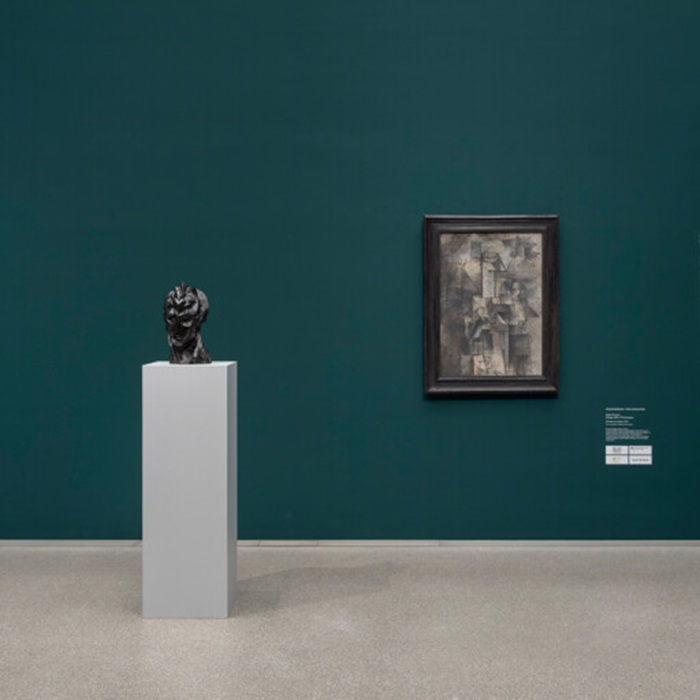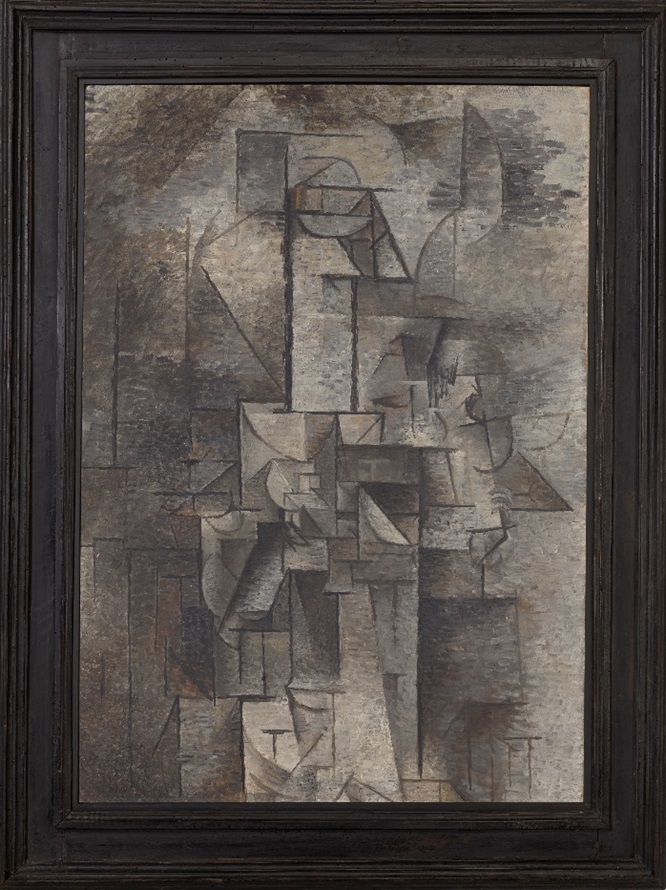The Bayerische Staatsgemäldesammlungen announces the acquisition of a key work of Analytical Cubism. For the first time in over 50 years, the Pinakothek der Moderne has succeeded in permanently securing a top work of Cubism for its Modern Art Collection.
Image above: Pablo Picasso, Femme au violon, 1911, Öl auf Leinwand, 92 x 65 cm,
mit Renaissance-Kassettenrahmen (16. Jh., Toskana),Sammlung Moderne Kunst in der Pinakothek der Moderne, 2022 bis 2024 erworben mit großzügiger Unterstützung der Ernst von Siemens Kunststiftung,des Freistaat Bayern, der Beauftragten der Bundesregierung für Kultur und Medien, der Kulturstiftung der Länder,der Würth-Gruppe und von Fritz Schäfer, Schweinfurt, Foto: Bayerische Staatsgemäldesammlungen, Sibylle Forster © Succession Picasso / VG Bild-Kunst, Bonn 2024
Pablo Picasso’s ‘Femme au violon’, created in the spring of 1911, marks the culmination and end point of non-objectivity in Picasso’s Cubist oeuvre and the almost complete dissolution of the object. The composition captivates through the delicate poetry of the pointillistically vibrant brushwork, reduced to grey, brown and ochre tones, and the consistent geometric dissection of figure and instrument. Form and background are linked in a linear grid structure. The stippling application of colour makes the picture pulsate simultaneously in cloudy zones of light and dark.
The development of Picasso’s analytical-cubist vocabulary is now grandly visible in Munich, from the ‘Crystal Bowl’ (1909) to the ‘Fan’ (1910) and the ‘Woman with Violin’ (1911). The juxtaposition of the large-format ‘Woman with Violin’ with George Braque’s highly oval ‘Woman with Mandolin’ (1910), acquired back in 1967, also reveals one of the formative artistic dialogues of the modern avant-garde in the Pinakothek der Moderne in congenial works – the close interweaving of Picasso and Braque during the development of analytical Cubism, which is unique in art history. Until now, the Munich collection has lacked a central work from Picasso’s heyday that is dedicated to analysing the human form.
The painting is of inestimable cultural value for the early reception and establishment of French Cubism in Germany. ‘Femme au violon’ has an illustrious provenance and exhibition history. On loan from the pioneering Parisian art dealer Daniel-Henry Kahnweiler, it epitomised Picasso’s most recent stylistic developments at the legendary ‘Sonderbund’ exhibition in Cologne in 1912 and, following its immediate acquisition by the collector and art dealer Alfred Flechtheim, was shown at the first German Picasso retrospective at the ‘Moderne Galerie Heinrich Thannhauser’ in Munich in 1913. After the work made its way to the famous collection of the Krefeld textile manufacturer Hermann Lange in around 1927 and was passed on within the family through succession, it returned to Munich in 2014 – around a century after its first presentation – initially as a permanent loan to close a significant gap in the Cubism holdings of the Sammlung Moderne Kunst. After the last pioneering Cubist works by Pablo Picasso, Georges Braque and Juan Gris were bequeathed to the Bayerische Staatsgemäldesammlungen in 1971 by Woty and Theodor Werner, it has now been possible to permanently secure Pablo Picasso’s ‘Femme au violon’ for the Free State of Bavaria through several years of endeavour and thanks to an alliance of six sponsors. This would not have been possible without the early and unconditional commitment of the Ernst von Siemens Art Foundation.
Picassos „Femme au violon“ wurde nun anlässlich dieser Neuerwerbung und Präsentation in Saal 29 eigens neu gerahmt. Das Gemälde erhielt durch Knoell Rahmen, Basel, einen italienischen Renaissance-Kassettenrahmen (Nussbaumholz, Toskana, frühes bis mittleres 16. Jahrhundert). Auch George Braques, „Femme à la Mandoline“, wurde ebenfalls in Basel mit einem neu angefertigten, erstmals ovalen Gemälderahmen aus Kieferholz nach einem barocken Profil ausgestattet.
Room 29 of the Pinakothek der Moderne presents Cubist works from the Modern Art Collection on the occasion of the new acquisition. Cubism already had an early heyday in Munich before the First World War: In February 1913, gallery owner Heinrich Thannhauser (1859-1934) organised the world’s first Picasso retrospective of the then 31-year-old painter in his ‘Modern Gallery’ at Theatinerstrasse 7. In addition to ‘Woman with Violin’, which has now been secured for Munich, Picasso’s paintings ‘Fan’ and ‘Crystal Bowl’, which have been part of the Bavarian State Painting Collections since 1971, were also on display at this exhibition.

From 1906/07, Pablo Picasso and Georges Braque developed Cubism as a radical break with the tradition of painting. The criticism of the reproduction of the visible and the conceptual dissection of the object into individual geometric forms made Cubism a decisive starting point for the conceptual innovations of the avant-garde. The presentation shows stylistic innovations from analytical to synthetic Cubism, but also further developments by Juan Gris, George Braque and Pablo Picasso during the 1920s through to Sigmar Polke’s ironic examination of the Cubist dissolution of objects in his ‘Nude with Violin’ from 1968.
Oliver Kase, Collection Director | Modern Art Collection, Head of the Classical Modern Art Collection
Prof. Dr Bernhard Maaz, Director General of the Bavarian State Painting Collections: ‘One of the largest acquisitions of a German museum in recent decades is thanks to the magnificent and resolute alliance of sponsors and politicians, foundations and private individuals. I would like to thank everyone involved, from the Ernst von Siemens Art Foundation, which has been a motivating force from day one, to the state and federal levels, the Bavarian Directors’ Conference, Reinhold Würth’s company and Fritz Schäfer as a selfless patron.’
Markus Blume, Minister of State for Science and Art, Free State of Bavaria: ‘Picasso’s “Femme au violon” becomes a Munich native – in a way, our cubist version of Mama Bavaria! Thanks to the great interplay of politics, foundations, business and private patronage, Picasso’s iconic work of art will be at home in the heart of our cultural metropolis of Munich. The acquisition is a fantastic joint endeavour and a tremendous gain for the Bavarian State Painting Collections and our cultural state of Bavaria. I would like to thank the Minister of State for Culture, the Kulturstiftung der Länder, the Ernst von Siemens Kunststiftung, the Würth Group and the private patron Fritz Schäfer for their support! This shows how united commitment enriches our national cultural landscape’.
Dr Martin Hoernes, Secretary General of the Ernst von Siemens Art Foundation: ‘Femme au violon’ is a Munich painting! In 1913, the collector Franz Kluxen showed it here at the first Picasso retrospective and it was initially on loan to the Pinakothek der Moderne as a high-calibre addition to the collection. As the main sponsor, the EvSK covered a quarter of the purchase price and initiated the acquisition for Munich in 2022.
Prof Dr Markus Hilgert, Secretary General of the Kulturstiftung der Länder: ‘Picasso’s “Femme au violon” is not only of outstanding importance for the history of the development of Cubism – it is also of national relevance with regard to the early reception of Picasso in Germany and is directly linked to the city of Munich in terms of its provenance and exhibition history. The Kulturstiftung der Länder was therefore very happy to support the Pinakothek der Moderne in its purchase.’
Minister of State for Culture Claudia Roth: ‘As a brilliant artist, Picasso had an outstanding influence on 20th century painting. His ‘Femme au violon’ is considered a true masterpiece of Cubism and is therefore of inestimable art-historical value. The fact that this painting by Pablo Picasso has now finally found a permanent place in the Pinakothek der Moderne is a great gain for Munich and the entire German museum landscape. I am very pleased that the acquisition has made it possible to permanently preserve a piece of the artistic avant-garde in Germany for a broad public. This required a strong alliance. An alliance that is clearly committed to culture through its financial involvement. The cooperative collaboration between the federal government, the Free State of Bavaria, the Cultural Foundation of the Federal States and the Ernst von Siemens Art Foundation is a great example of the high value placed on culture by the federal and state governments.’
Pablo Picasso, ‘Femme au violon’ is on display in room 29
Provenance of the painting: earliest 1911-1912 Daniel Henry Kahnweiler, Paris; 1912 Alfred Flechtheim, Düsseldorf; latest 1913 to at least 1917 Franz Kluxen, Münster and Boldixum; at least 1920 to at least 1922 Max Leon Flemming, Hamburg; 1927 Galerie M. Goldschmidt & Co, Frankfurt am Main (on commission); no earlier than 1927, no later than 1931 to 1942 Hermann Lange, Krefeld / Berlin; 1942 to 1964 Marie Lange, Krefeld; since 1964 private collection; 1994 to 2004 on loan from private ownership to the Staatliche Museen zu Berlin, Neue Nationalgalerie; 2004 on loan from private ownership to the Staatliche Museen zu Berlin, Museum Berggruen; since 2014 on loan from private ownership to the Bayerische Staatsgemäldesammlungen, Sammlung Moderne Kunst in der Pinakothek der Moderne, Munich
Acquired 2022 to 2024 with the generous support of the Ernst von Siemens Art Foundation, the Free State of Bavaria, the Federal Government Commissioner for Culture and the Media, the Cultural Foundation of the Federal States, the Würth Group and Fritz Schäfer, Schweinfurt.
WHERE?
PINAKOTHEK DER MODERNE, Room 29
Barer Straße 40
80333 München






